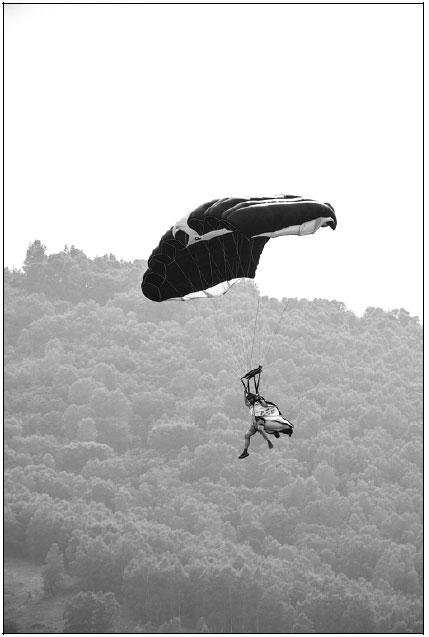Gliding into unknown territory
Wingsuit flying is more than just a sport for Xu Kai, Li Yingqing reports in Kunming.
If you remember the scene in the movie Transformers: Dark of the Moon where you can fly through high-rise buildings like a bat, then you know about wingsuit flying.
Xu Kai is known as "China's first wingsuit flyer". He has practiced the sport for six years.
Wingsuit flying is often thought to be extremely dangerous. It has long been misunderstood.

|
Xu Kai is known as "China's first wingsuit flyer". He has practiced the sport for six years. Photos Provided to China Daily |
"Wingsuit flying consists of low-altitude flying and high-altitude flying," says Xu.
"Like skydiving, the risk of high-altitude wingsuit flying is not high. But low-altitude wingsuit flying is much more dangerous."
You must have at least 500 successful high-altitude flying sorties to practice the sport. Low-altitude wingsuit flying, on the other hand, requires a stable personality and psychological maturity.
Xu says he was not afraid but, rather, nervous when he first tried skydiving, paragliding and wingsuit flying.
"My mind used to go blank because I did not know what was going to happen. Now, I have learned to enjoy flying."
Xu believes wingsuit flying is the best way to release mental pressure.
"After you jump from an aircraft and fly through the sky like a bird, your pressure and depression will immediately vanish. And it offers you a new perspective to understand your life and observe the world," says Xu.
For Xu, wingsuit flying is more about attitude than a lifestyle. He wishes more people could experience its pleasure.
More people have joined this sport recently. About 3,000 people do low-altitude wingsuit flying globally, and the number is growing in China.
Wingsuit flying, which first began in the late 1990s, grew from extreme skydiving.
A wingsuit adds surface area to the human body to enable a significant increase in lift in order to help the flyer soar 3 meters forward when falling 1 meter. A flyer can sail from any point that provides sufficient altitude, typically a high building, tower, bridge, cliff or aircraft.
The unpowered flight has a forward speed of 200 kilometers per hour and a falling speed of 50 kph.
The ups and downs of life enticed Xu to develop a connection with the sport.
Xu was born and raised in Changchun, capital of Northeast China's Jilin province, in 1972. Xu went to Guangzhou to start a business after graduating from college.
But his partner suddenly fell ill. Xu, then 30, was deeply affected by the news and finally decided to close the business and move to Beijing.
From 2002, Xu tried cycling, shooting, sailing, diving and skydiving to fulfill his childhood dreams. But he finally settled on skydiving. And under Zhang Angang, the former national head coach, Xu completed his training in skydiving in 2005.
In January 2013, Xu completed both high-and low-altitude wingsuit-flying training and became the first wingsuit flyer in China.
In April that year, Xu and other two top flyers flew over the Sidu River Bridge, the highest completed suspension bridge in the world at that time, setting a world record. And he became the first Chinese to do wingsuit flying.

The Sidu River Bridge in Enshi in Central China's Hubei province is built between two mountains and over a 560-meter-deep valley with an impressive span of 900 meters. And it overtook the 343-meter-high Millau Bridge in France to become the highest bridge in the world when it was completed.
In April 2014, Xu and his schoolmates set up China's first wingsuit-flying club. And with the purchase of the ProBase World Cup, which was then engaged in wingsuit-flying events, Xu established the brand Wings for Love.
He then launched the Wingsuit Flying World Championship, Wings for Love, in China and for the first time combined the high-risk extreme sport with public-welfare activities, like raising money for poor children.
Now, the event is called the "Olympics of wingsuit flying" and is the largest international wingsuit-flying event.
The event donates all prizes to locals wherever it's held.
In 2015, the finals of the first Wings for Love were held in Zhaotong in Yunnan province, attracting more than 40 top flyers from all over the world.
In 2016, the event was held in Badong, Hubei province, and Chinese flyers took part for the first time.
The finals of 2017 and 2018 were held in Jinggu county, Yunnan province.
"Flying for love" is the permanent theme.
Since 2015, the Wings for Love championship committee has donated 600,000 yuan ($88,800) for orphans and poor children in the Ludian area of Yunnan province.
It has also donated 200,000 yuan for students in the Badong and Jinggu special education schools, respectively.
Last year, all the prize money was donated to poor children in Jinggu. The committee replaced equipment in the canteen of the Jinggu Special Education School and offered home appliances to 22 local ethnic Lahu families.
"I experienced the Wenchuan earthquake in 2008. And I'm deeply convinced that we need to motivate the local people to face natural disasters," Xu says.
"Since Zhaotong and Jinggu have both experienced earthquakes, choosing to hold the event in these two places is of great significance."
Liu Miao, Xu's wife, supports her husband. She closed her own coffee shop in Beijing to devote herself to wingsuit flying.
"Although it is very dangerous, I believe he is a very careful man, and he pays attention to detail. I don't worry about him," Liu says.
Xu has been "suspended" from the sport for three years because of an injury.
He has changed from a flyer to an advocate.
He says he wants to try high-altitude flying next year if his health allows.
Contact the writer at liyingqing@chinadaily.com.cn
Zhang Qiuting contributed to this story.
(China Daily 01/22/2019 page14)



















